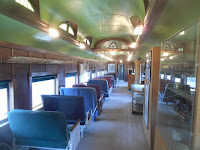The Arizona Railway Museum is a non-profit volunteer organization with a basically static collection in the Phoenix suburb of Chandler. It's open on weekends, but due to the climate the museum is closed from June to August or the middle of September (our busy season!!). They moved to the current location seven or eight years ago. The storage yard is nicely laid out, and there is an interchange switch with an active freight spur. Some of the cars are privately owned and are Amtrak certified, so excursion trips can be run.
This building houses the visitor's center, gift shop, offices, and crew facilities. The visitor's center is fairly small but has some nice displays.
And now, out into the yard. Most of the collection consists of relatively modern passenger cars, largely from the Santa Fe and SP. Some are open for visitors; others are privately owned and not part of the collection.
Here's a good example of making a virture of necessity. This old heavyweight was presumably gutted for work train service. Along one side, there are seats from many different railroads and eras, all labeled. It makes an interesting display. And I was told that Jerry McGonigle had worked on this car. It looks nice!
At the far end, there are a couple of streetcar seats, and a wooden bench from a Hawaiian narrow-gauge car.
The signal display.
This Toronto PCC was on display in downtown Phoenix for several years, advertising the coming of a new light-rail system. After the LRV's started running, it was no longer needed and sold for $1 to the museum.
This is an E8 originally from the North Western, then Metra. As the sign says, it passed through several hands before winding up here.
The museum's standard signs hook onto the rail, as you can see here. The signage on the whole is very good.
This is the only steam locomotive. You can walk up into the cab; all the controls are labeled, and you can ring the bell
I talked to a couple of volunteers who were working on this box car, which will serve for additional parts storage and a workshop. They have about 50-75 active volunteers, many of whom work in the gift shop or as docents, for school and charter groups. There's always more maintenance to be done, of course, and several things have been repainted. In this climate, though, indoor storage is not a priority.

































No comments:
Post a Comment